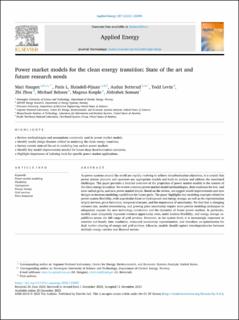| dc.description.abstract | As power systems around the world are rapidly evolving to achieve decarbonization objectives, it is crucial that power system planners and operators use appropriate models and tools to analyze and address the associated challenges. This paper provides a detailed overview of the properties of power market models in the context of the clean energy transition. We review common power market model methodologies, their readiness for low- and zero‑carbon grids, and new power market trends. Based on the review, we suggest model improvements and new designs to increase modeling capabilities for future grids. The paper highlights key modeling concepts related to power system flexibility, with a particular focus on hydropower and energy storage, as well as the representation of grid services, price formation, temporal structure, and the importance of uncertainty. We find that a changing resource mix, market restructuring, and growing price uncertainty require more precise modeling techniques to adequately capture the new technology constraints and the dynamics of future power markets. In particular, models must adequately represent resource opportunity costs, multi-horizon flexibility, and energy storage capabilities across the full range of grid services. Moreover, at the system level, it is increasingly important to consider sub-hourly time resolution, enhanced uncertainty representation, and introduce co-optimization for dual market clearing of energy and grid services. Likewise, models should capture interdependencies between multiple energy carriers and demand sectors. | en_US |

